Kirkland Lake, Ontario – November 3, 2021 – RJK Explorations Ltd (“RJK” or “the Company”) (TSX-V: RJX.A, US OTC: RJKAF) has received results from CF Mineral Research in Kelowna BC, from seven large-tonnage, on-surface kimberlite discoveries. Kimberlite samples totalling 12.2 tonnes combined were tested to determine the variability of the geochemistry, to develop preliminary comparisons to other kimberlite fields, and to determine the most promising locations suitable for excavating large tonnage bulk samples. RJK is pleased to report that CF Mineral Research confirms the Lorrain Twp. kimberlite discoveries host lherzolite-type kimberlite where large diamonds (50 carats+) are typically found. The unique geological setting presents the availability of unconsolidated near-surface kimberlite material that is amenable to exceptional low cost processing wherein minimum 50 tonne bulk samples, from multiple locations, can be used to determine the large diamond potential.
Synopsis
The indicator mineral geochemistry from all 7 kimberlite bodies indicates the kimberlite magma has incorporated lherzolitic peridotite enriched in olivine, orthopyroxene along with chromium and aluminum spinels and garnets. This region at the base of the lithosphere and upper mantle is conducive for the growth of large diamonds in the diamond stability field at depths of 150 km to 200 km. The high temperature ilmenite peridotites contain megacrysts favouring larger diamond overgrowths forming at temperatures ranging from 1200 Co to 1400 Co. The proto-kimberlite magma indicates an origin of deeper levels in the upper mantle as down to the Transition Zone, from 200 km to 400+ km, based on preliminary whole rock analysis. Samples taken from 4 RC drill holes from the Paradis, Robin’s Place, Gleeson and HSM kimberlites returned average compositions as follows: SiO2: 46.8%, CaO: 16.9%, Al2O3: 8.8%, Fe2O3: 3.2%, K2O: 1.9%, MgO: 4.3%. Na2O: 1.9%, Cr2O3: .04%, Mn2O3: .06%, TiO2: .29%.
Visual Model Explanation:
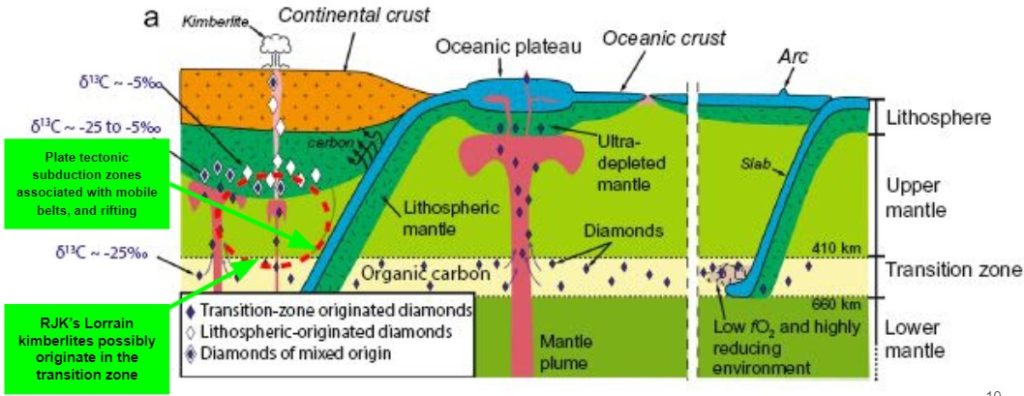
Source: Oceanic and super‑deep continental diamonds share a transition zone origin and mantle plume transportation; Luc S. Doucet, Zheng‑Xiang Li & Hamed Gamal El Dien; www.nature.com/scientificreports/ published on-line: Aug 20,2021; modified by RJK Expl Geology
Oceanic and super-deep continental diamonds form in the mantle transition zone using subducted carbon, and brought to the lithospheric levels by mantle plumes. Lithospheric Diamonds and Diamonds of Mixed Origin (as rims over the super-deep diamonds) develop in the continental lithosphere. Geochemistry of RJK’s KIMs suggest possible origins as deep as the transition zone, based on temperature and pressure lab determinations. High quantities of olivine silicates suggest a very deep magma source, arguably where large diamonds originate.
Comparisons
Dr. Charles E. Fipke previously stated RJK’s Paradis Kimberlite hosts diamond inclusion lherzolite indicators such as those contained at the Victor diamond mine in Ontario and other diamond mines in Lesotho and elsewhere. This statement was also true for surrounding kimberlites, with emphasis on the Nicol Kimberlite body. The picro-ilmenite plots show similarities to the Yakutia Kimberlite Fields in Siberia showing peridotite magma affinity. Cr-poor ilmenites (0.04 to 0.23 wt%Cr2O3; 9.7 to 11.3 wt% MgO) occur as intergrowths with type II diamonds, and the Lorrain Kimberlite Field ilmenite plots display these same ranges. Comparisons were also made to De Beers Victor Lherzolite Diamond Mine, which was unique in its chemistry, yielding exceptional quality diamonds, but also hosting very few microdiamonds. Victor lherzolitic garnet inclusions have unusually high MnO contents, with 88% exceeding the MnO cut-off >.36 weight% MnO for diamond facies garnets. (Refer to following histograms). The Lorrain Twp. kimberlite results suggest a certain level of diamond resorption (especially for any smaller stones), the kimberlite magma also has experienced a reducing environment conducive for diamond preservation based on picro-ilmenite geochemistry. The picro-ilmenite plots from the Lorrain Twp. kimberlites compare favourably with the Yakutia kimberlite field plots depicted in the Geotechnical Discussion.
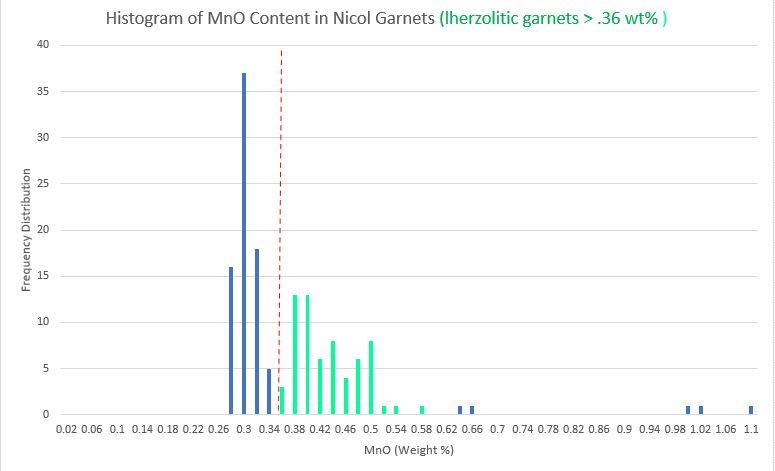
Source: RJK Expl Geology
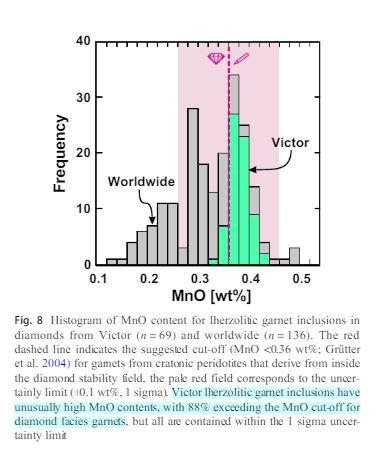
Source: The Victor Mine (Superior Craton, Canada): Neoproterozoic lherzolitic diamonds from a thermally-modified cratonic root; T. Stachel et al; Article in Mineralogy and Petrology · May 2018
Geotechnical Discussion
Dr Charles Fipke’s lab, CF Mineral Research in Kelowna BC and Microlithics in Thunder Bay Ontario processed 12.2 tonnes of kimberlite recovered by bulk sampling, diamond drill coring and reverse circulation drilling methods from 7 kimberlite bodies over 10 months. A summary of kimberlite indicator mineral and diamond results are presented below:
Paradis Pond and Beaver Dam
From 156 kgs of drill core, samples were selected from 4 drill holes (PP-20-03,04,08,09) and were processed by CFM for a concentrate weight of 341 g from which 179g were picked. A total of 1,914 grains were picked and 283 grains probed and classified into 6 diamond indicator minerals: 18 were diamond inclusion olivine/forsterite; 2 were G9 eclogitic garnets believed to originate between 150 km to 200 km depths; 8 were diamond inclusion clinopyroxenes; 17 kimberlite chromites including 7 high titanium chromites, 10 were G10 peridotitic garnets; 2 were diamond inclusion G11 garnets, Of importance is that 18 olivine/forsterite grains classify in all diamond inclusion fields and 2 G9 eclogitic and 16 high pressure megacrystic garnets are associated with diamond formation at depths of about 200 km or more. A total of 5 microdiamonds were recovered and all stones are described as: natural, white, chip with adamantine lustre, very strong colour emission with no inclusions. One diamond from holes PP-20-03/04 is described as an irregular crystal with fractured surface, weakly yellow with adamantine lustre, very strong colour emission with no inclusions. Of particular significance is the diamond bearing Paradis kimberlite may have originated in the upper mantle passing through both group 1 and group 2 eclogitic magma fields and therefore can assimilate both group 1 and group 2 eclogitic clinopyroxenes and garnets.
A 16 hole RC drilling campaign was initiated in the vicinity of drill hole PP-20-04 using a 16 m x 16 m testing array. RC drilling using 3.5” rod diameter recovered 1,070 kg which was processed by Microlithics using their DMS plant. A 36 kg concentrate was produced and then fired in a caustic fusion process to recover diamonds. No diamonds were recovered. but note that given the size of the microdiamonds discovered in the Company’s diamond drill core, the possibility exists that microdiamonds were lost in the RC drilling process which extracts the cuttings through a 1” annulus inside the rods.
Paradis Dam
From A 864 kg RC samples, 717 g of heavy mineral concentrates were then picked for a weight of 179 g , of which 1,311 grains were picked and 243 grains probed and classified into 6 diamond indicator minerals: 2 were diamond inclusion olivine forsterites, 3 were G9 eclogitic garnets, 1 was a diamond inclusion G11-1 garnet, and 1 was a diamond inclusion chromite, all formed in the diamond stability field along with the diamonds. There were no microdiamonds recovered from the 864 kg RC drilling sample. Analysis of the 1,267 picro-ilmenite microcrysts indicate reducing conditions suitable for diamond preservation in the magmas of kimberlite and lamproite affinity with crystallization temperatures ranging from 669 Co to 1411 Co.
Nicol
From a 56 kg RC sample, a picking weight from 670 g of heavy mineral concentrates, 3,386 grains were picked and 171 grains probed and classified into 6 diamond indicator minerals: 14 were diamond inclusion olivine forsterites, 5 were G10-2 peridotitic garnets, 1 was a diamond inclusion G11 garnet, 4 were diamond inclusion clinopyroxenes and 5 were diamond inclusion chromites, all formed in the diamond stability field along with the diamonds. There were no microdiamonds recovered from the 56 kg RC drilling sample.
Nicol’s Forsterite megacrysts suggest a very deep source, based on the Mg vs. Fe content of the olivine. Analysis of the 102 picro-ilmenite microcrysts indicate reducing conditions suitable for diamond preservation in the magmas of kimberlite and lamproite affinity with crystallization temperatures ranging from 1174 Co to 1318 Co. Refer to attached Cr2O3 / MgO plot
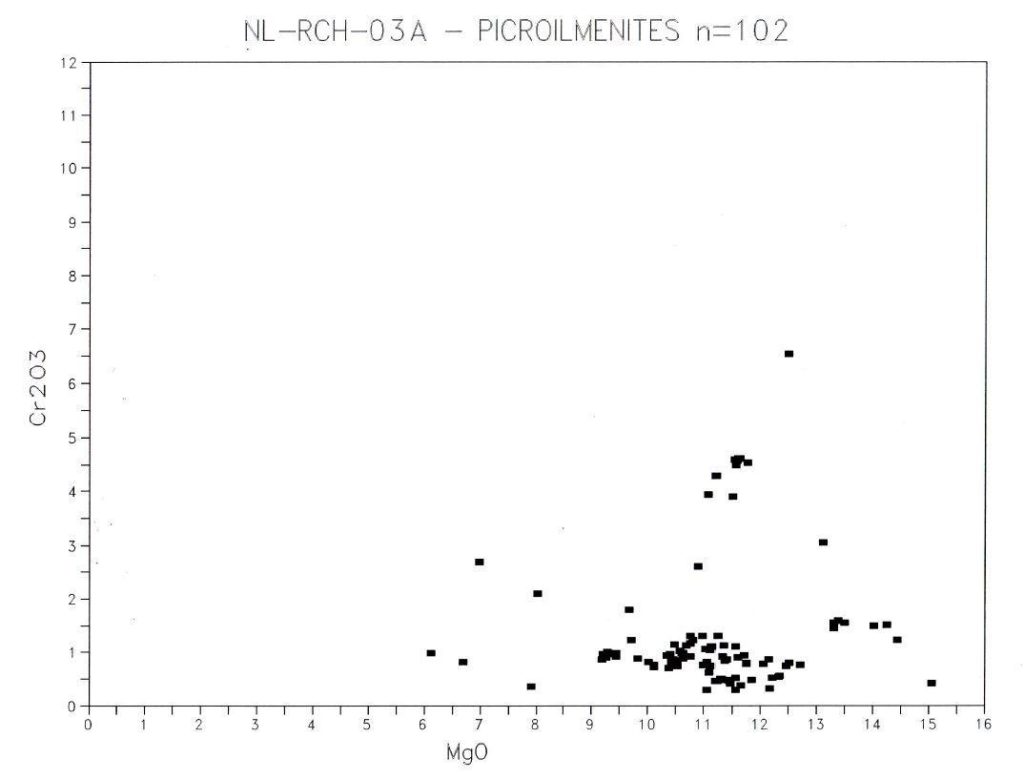
Source: CFM Mineral Research
Gleeson
A 1,536 kg RC sample was processed by Microlithics and a 54 kg core sample by CFM, for a a picking weight from 157 g of heavy mineral concentrates, 1,412 grains were picked and 193 probed and classified into 6 diamond indicator minerals: 8 were diamond inclusion olivine forsterites, 3 were G9 eclogitic garnets, 4 were diamond inclusion clinopyroxenes and 2 were diamond inclusion chromites, all formed in the diamond stability field along with the diamonds. There were 3 (.106 microns} microdiamonds recovered from the 54 kg drill core sample. Analysis of the 64 picro-ilmenite microcrysts indicate reducing conditions suitable for diamond preservation in the magmas of kimberlite and lamproite affinity with crystallization temperatures ranging from 669 Co.to 1411 Co. Refer to attached Cr2O3 / MgO plot.
A 20 hole RC drilling campaign was initiated over the Gleeson conductance anomaly utilizing a N/S and E/W drill fence array with 200 m spacing between holes. RC drilling using 3.5” rod diameter recovered 1,509 kg which was processed by Microlithics using their DMS plant. A 31 kg concentrate was produced and then fired in a caustic fusion process to recover diamonds. No diamonds were recovered.
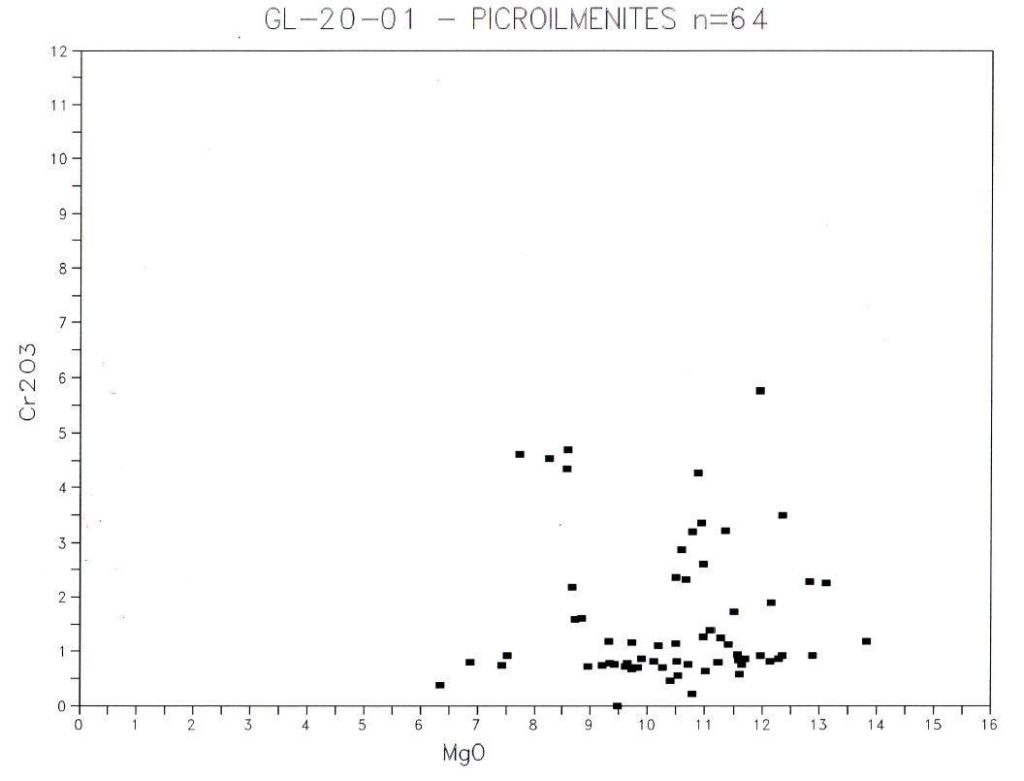
Source: CFM Mineral Research
Robin’s Place
A 1,119.7 kg RC sample was processed at Microlithics to a concentrate along with a 26 kg core sample by CFM for a picking weight of 104 g of heavy mineral concentrates. 1,673 grains were picked and 142 grains probed and classified into 6 diamond indicator minerals, 1 was a G9 eclogitic garnet, 10 were diamond inclusion clinopyroxenes, all formed in the diamond stability field along with the diamonds. There were 2 (.106 microns} microdiamonds recovered from the 26 kg drill core sample. Analysis of the 48 picro-ilmenite microcrysts indicate reducing conditions suitable for diamond preservation in the magmas of kimberlite and lamproite affinity with crystallization temperatures ranging from 788 Co.to 1098 Co. Refer to attached Cr2O3 / MgO plot.
A 6 hole RC drilling campaign was initiated over the Robin’s Place conductance anomaly utilizing a N/S and E/W drill fence array with 200 m spacing between holes. RC drilling using 3.5” rod diameter recovered 1,131 kg which was processed by Microlithics using their DMS plant. A 16.5 kg concentrate was produced and then fired in a caustic fusion process to recover diamonds. No diamonds were recovered.
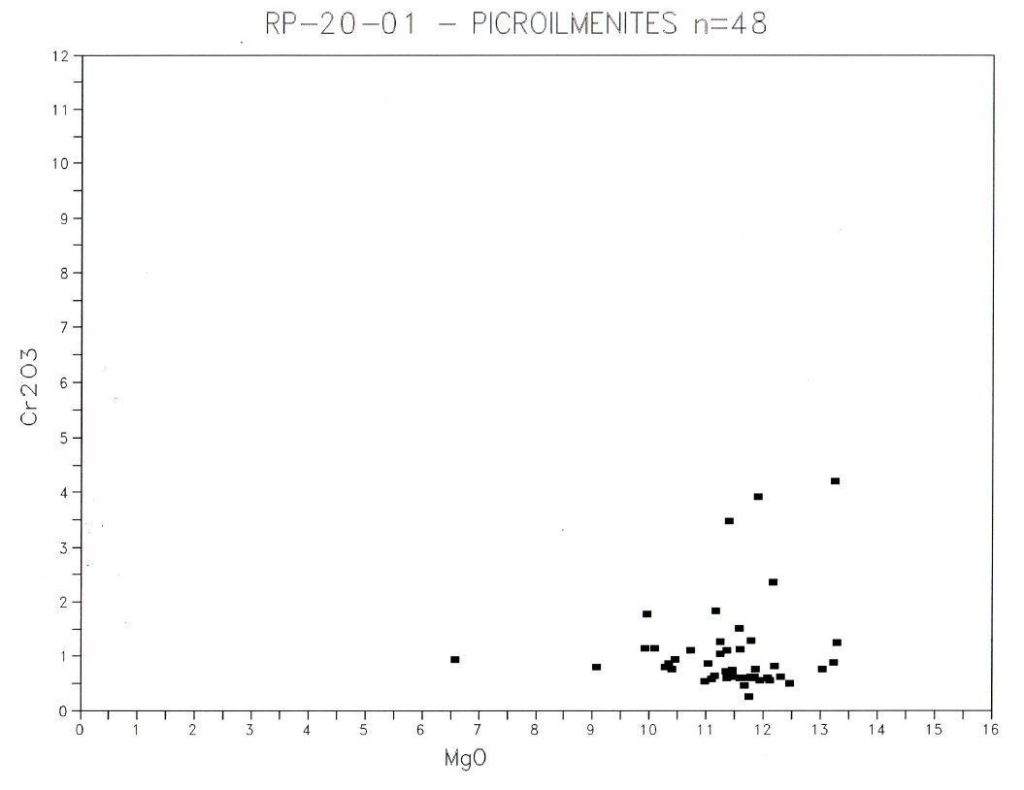
Source: CFM Mineral Research
Lightning
A picking weight from 405 g of heavy mineral concentrates was taken from a 22 kg core sample. 1,609 grains were picked and 258 grains probed and classified into 6 diamond indicator minerals: 14 were diamond inclusion olivine forsterites, 5 were G9 eclogitic garnets, 12 were diamond inclusion clinopyroxenes, all formed in the diamond stability field along with the diamonds. There were no microdiamonds recovered from the 22 kg drill core sample. Analysis of the 1,267 picro-ilmenite microcrysts indicate reducing conditions suitable for diamond preservation in the magmas of kimberlite and lamproite affinity with crystallization temperatures ranging from 744 Co.to 1481 Co. Refer to attached Cr2O3 / MgO plot.
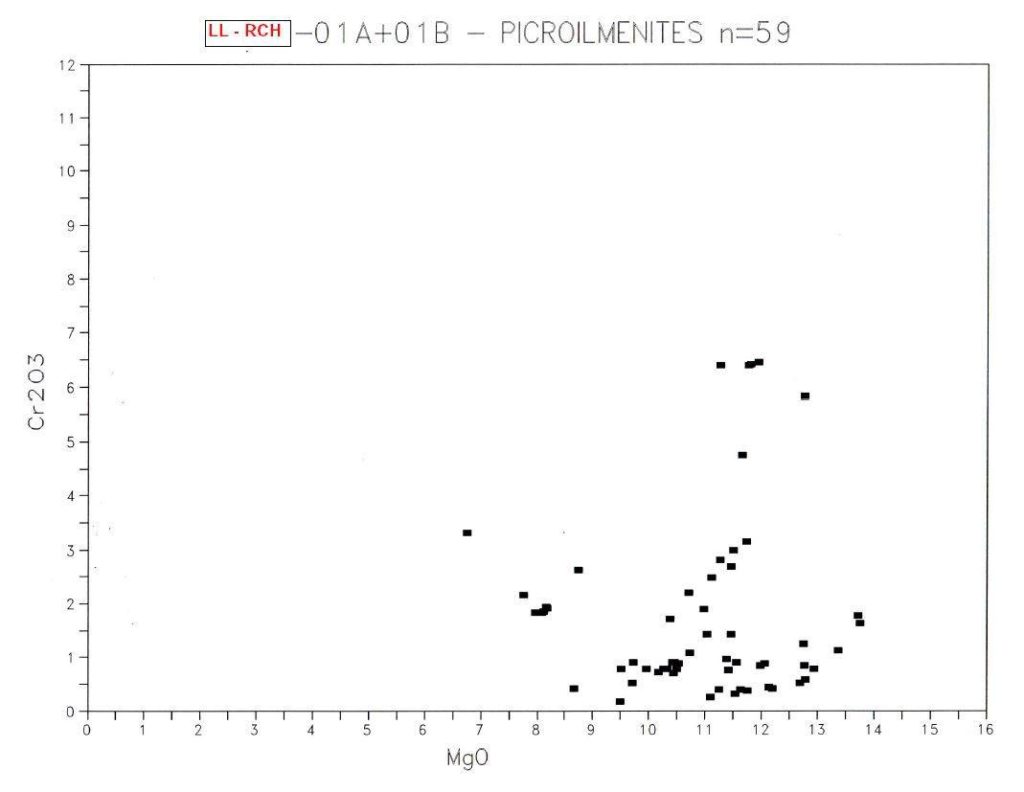
Source: CFM Mineral Research: Modified by RJK Expl Geology
HSM
From a 2,522 kg RC sample, a picking weight from 935 g from 41 kg of heavy mineral concentrates, 1,272 grains were picked and 478 grains probed and classified into 6 diamond indicator minerals: 31 were diamond inclusion olivine forsterite, 22 were G9 eclogitic garnets, 1 was a diamond inclusion G11-1 garnet, and 1 was a diamond inclusion chromite, all formed in the diamond stability field along with the diamonds. There were no microdiamonds recovered from these concentrates. Analysis of the 127 picro-ilmenite microcrysts indicate reducing conditions suitable for diamond preservation in the magmas of kimberlite and lamproite affinity with crystallization temperatures ranging from 669 Co.to 1411 Co. Refer to attached Cr2O3 / MgO plot.
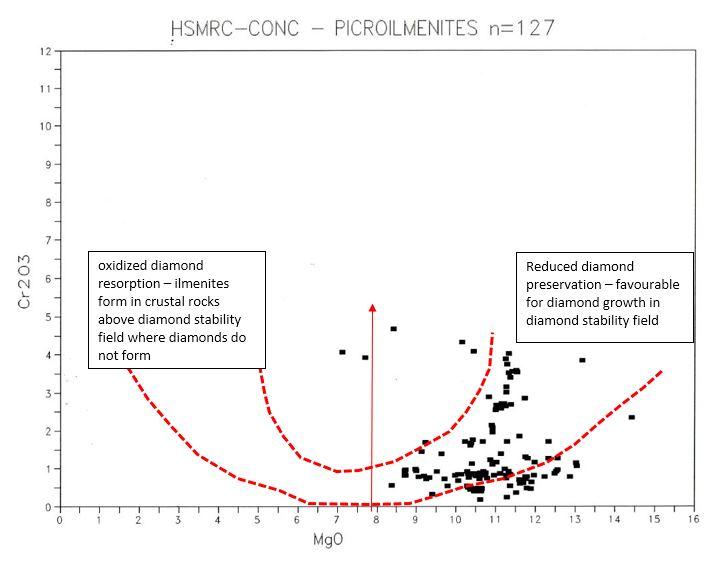
Source: CFM Mineral Research: Modified by RJK Expl Geology
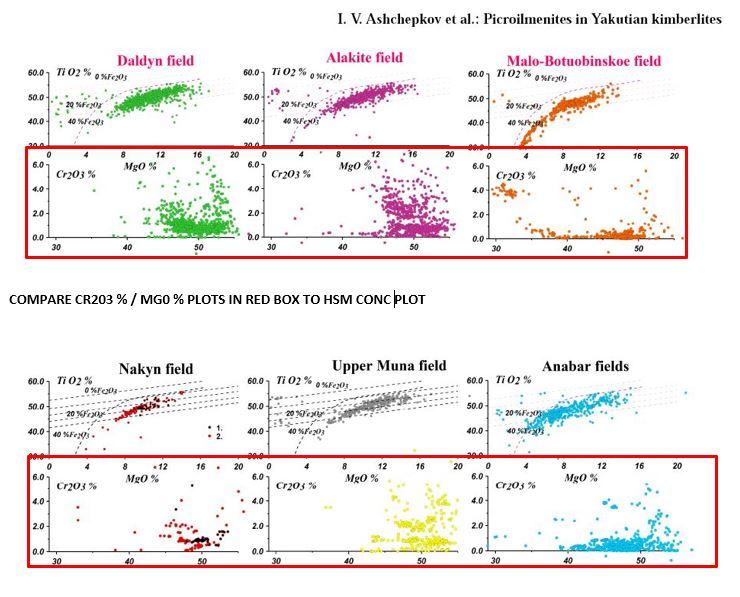
Source: Picro ilmenites in Yakutian kimberlites: variations and genetic models I. V. Ashchepkov et al, Solid Earth, 5, 915–938, 2014: Modified by RJK Expl Geology
Gravel Pit
From a 1,266 kg RC sample, a picking weight from 538 g from 14 kg of heavy mineral concentrates, 1,156 grains were picked and 582 grains probed and classified into 6 diamond indicator minerals: 25 were diamond inclusion olivine forsterites, 37 were G9 eclogitic garnets, 6 were diamond inclusion G11-1 garnets, 5 were diamond inclusion clinopyroxenes and 1 was a diamond inclusion chromite, all formed in the diamond stability field along with the diamonds. There were no microdiamonds recovered from these concentrates. Analysis of the 333 picro-ilmenite microcrysts indicate reducing conditions suitable for diamond preservation in the magmas of kimberlite and lamproite affinity with crystallization temperatures ranging from 918 Co.to 1105 Co.
The Company has updated the Investor presentation with some of the preliminary results, and the complete CF Mineral Research report will be posted to RJK’s website once all dot plot diagrams are completed.
2020 Trench Excavation Sampling
In November 2020, RJK excavated 3 batches of kimberlite material from 3 trenches in the Paradis Pond area totalling 3,583 kg. The trenches were selected in areas where overburden depths were drill indicated at 3 to 4 m. The reach of the excavator bucket was able to cut into the top layer of the kimberlite body approaching 4 meter depths but also encountered fluvial outwash mixed with kimberlite olivine matrix at 3m level. When the samples were processed by Microlithics Lab, it was determined that significant dilution of overburden (30%) was incorporated into the sample. RC drilling in 2021 confirmed that significant erosion of the upper kimberlite contact exists with mixed unconsolidated fluvial outwash, however the kimberlite substrate is weakly indurated with a recognizable bedding foliation in clay-rich sections. No diamonds were recovered after processing the 3 batches and the samples were not representative of the main kimberlite body. RJK anticipates employing larger excavators to extend the depth reach up to 6m from surface.
Bulk Sampling
RJK recently took an approximate 40 tonne initial kimberlite test sample in one day using an excavator and a twenty tonne tandem truck. The Company intends to test concentration methods that could yield to discovery of valuable diamonds. The volcanic kimberlite ash and the country and mantle-derived oversize clasts must both be screened out at the first stage. On average 40% of the kimberlite consists of olivine sand with volcanic ash that is <3 microns in size. This will be collected for analysis with additional potential applications due to its carbon capture chemistry.
Glenn Kasner, President of RJK, stated, “With modest expenditures over the past 22 months, we feel we have created a tremendous opportunity for our shareholders. The Nipissing Diamond project started as a theory, and now we have 9 potential large tonnage kimberlite bodies, 7 of which have been determined as lherzolitic-type kimberlites from the diamond stability field. After months of sampling programs, it is thrilling for us to learn our kimberlites host the correct chemistry to find 50+ carat diamonds, and therefore, could represent the source of the 800 Carat Nipissing Diamond. Our kimberlites originate from an exceptionally deep source, which is conducive for large diamond formation. They are situated very close to the surface, within the Historic Cobalt Mining Camp, enabling easy access, and extremely cost effective bulk sampling. Now that the discoveries are made, yielding similar chemistry to other large, lherzolitic diamond mines in the world, we have initiated research into the most efficient methods to process bulk samples to attempt to find large diamonds. RJK has been referred to a team of experts in lherzolites to help us with that task.”
Mr. Peter Hubacheck, P. Geo, Project Manager for RJK and the Qualified Person as defined by National Instrument 43-101 has approved the technical disclosure in this release.
Contact Information
Glenn Kasner, President
Mobile: (705) 568-7567
info@rjkexplorations.com
Web Site: https://www.rjkexplorations.com/
Company Information: Tel: (705) 568-7445
Neither the TSX Venture Exchange nor its Regulation Services Provider (as that term is defined in the policies of the TSX Venture Exchange) accepts responsibility for the adequacy or accuracy of this release.
Forward Looking Information
This news release includes certain forward-looking statements, which may include, but are not limited to, statements concerning future mineral exploration and property option payments. Any statements contained herein that are not statements of historical facts may be deemed to be forward-looking, including those identified by the expressions “will”, “anticipate”, “believe”, “plan”, “estimate”, “expect”, “intend”, “propose” and similar expressions. Forward-looking statements involve known and unknown risks and uncertainties that could cause actual results, performance, or achievements to differ materially from those expressed or implied in this news release. Factors that could cause actual results to differ materially from those anticipated in this news release include, but are not limited to, the financial resources of the Corporation being inadequate to carry out its stated plans. RJK assumes no obligation to update the forward-looking statements or to update the reasons why actual results could differ from those reflected in the forward-looking statements except as required by applicable law.
